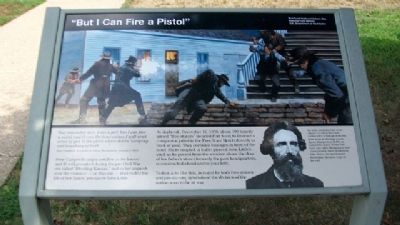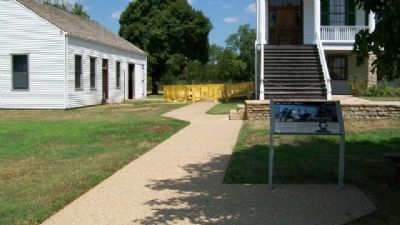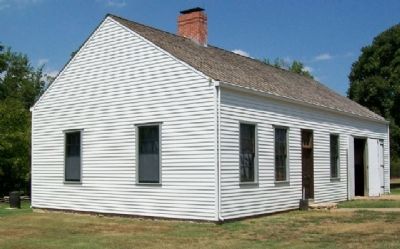Fort Scott in Bourbon County, Kansas — The American Midwest (Upper Plains)
"But I Can Fire a Pistol"
"But remember this, I am a girl, but I can fire a pistol and if ever the time comes I will send some of you to the place where there is [sic] 'weeping and knashing of teeth'...."
Gene Campbell, in a letter to James Montgomery, January 4, 1859.
Gene Campbell's anger testifies to the hatred and ill will prevalent during the pre-Civil War era called "Bleeding Kansas," and to her anguish over the violence - on this site - that ended the life of her fiancé, pro-slaver John Little.
At daybreak, December 16, 1858, about 100 heavily armed "free-staters" invaded Fort Scott to liberate a companion jailed in the Free State Hotel (directly in front of you). They corralled hostages in front of the hotel. Shots erupted. A bullet pierced John Little's skull as he peered from the window above the door of his father's store (formerly the post headquarters, reconstructed ahead and to your left).
Violent acts like this, initiated by both free-staters and pro-slavers, symbolized the division of the nation soon to be at war.
An artist envisioned the scene (above) in which free-state raiders force a hostage down the hotel steps as shooting erupts. James Montgomery (left), an ardent free-stater, led the Fort Scott raid. After Montgomery was chosen leader, fellow abolitionist John Brown (of later Harpers Ferry fame) declined to go on the raid.
Erected 1998 by National Park Service.
Topics and series. This historical marker is listed in these topic lists: Abolition & Underground RR • Settlements & Settlers. In addition, it is included in the Fort Scott, Kansas series list. A significant historical date for this entry is January 4, 1950.
Location. 37° 50.65′ N, 94° 42.294′ W. Marker is in Fort Scott, Kansas, in Bourbon County. Marker can be reached from Old Fort Boulevard. Marker is on the grounds of Fort Scott National Historic Site. Touch for map. Marker is in this post office area: Fort Scott KS 66701, United States of America. Touch for directions.
Other nearby markers. At least 8 other markers are within walking distance of this marker. Rank, Privilege, and Officers Row (here, next to this marker); "Hardy, Dashing Looking Fellows" (within shouting distance of this marker); Call 911: Civil War Style (within shouting distance of this marker); Back Yards (within shouting distance of this marker); "A Most Deplorable Condition" (about 300 feet away, measured in a direct line); Western Hotel: Symbol of Strife (about 300 feet away); Tallgrass Prairie Trail (about 300 feet away); "The Crack Post of the Frontier" (about 300 feet away). Touch for a list and map of all markers in Fort Scott.
Also see . . .
1. Bleeding Kansas. (Submitted on September 24, 2010, by William Fischer, Jr. of Scranton, Pennsylvania.)
2. James Montgomery. (Submitted on September 24, 2010, by William Fischer, Jr. of Scranton, Pennsylvania.)
Credits. This page was last revised on September 1, 2020. It was originally submitted on September 24, 2010, by William Fischer, Jr. of Scranton, Pennsylvania. This page has been viewed 1,200 times since then and 14 times this year. Last updated on April 2, 2012, by Aimee Kennedy of Aurora, Illinois. Photos: 1, 2, 3. submitted on September 24, 2010, by William Fischer, Jr. of Scranton, Pennsylvania. • Craig Swain was the editor who published this page.


